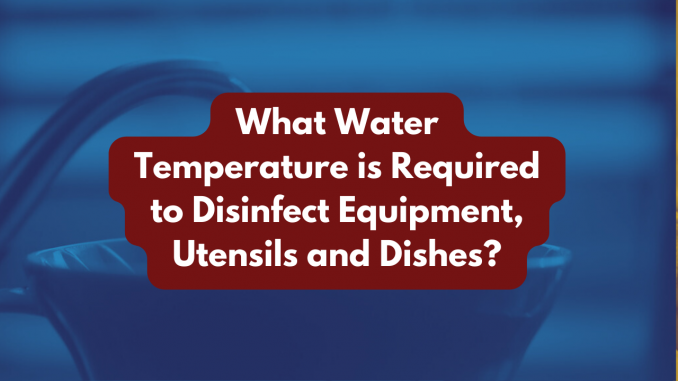
The temperature required to effectively disinfect equipment, utensils, and dishes depends on the method of disinfection being used. Washing your hands with soap does not effectively eliminate bacteria and you must use very hot water.
For disinfection certainty, surfaces must be washed at 80°C and maintained at that level for an extended period. However, this temperature is too high for hand washing and poses a significant risk of severe scalding.
Disinfection Water Temperatures
Here are some common methods for disinfection and their recommended temperatures:
Hot Water Disinfection: For manual dishwashing, the water temperature should be at least (171°F) 77°C For mechanical dishwashing (using a dishwasher), the water temperature should be around 150-165°F (65-74°C).
Chemical Disinfection: Chemical sanitisers such as chlorine bleach are often used in lower temperatures. Follow the product instructions for proper dilution and contact time.
Steam Sterilisation: Steam is effective for sterilisation. The temperature for steam sterilisation is typically around 250°F (121°C).It’s important to note that using too high a temperature for certain materials or equipment can lead to damage. Always follow the specific guidelines provided by the manufacturer for the items you are disinfecting. Additionally, local health codes and regulations may also specify temperature requirements for commercial food establishments.
Are there alternative methods for disinfection at lower temperatures?
Some chemical disinfectants may be effective at lower temperatures. Understanding and following the guidelines provided by the specific disinfectant product is crucial.
Is there a risk of scalding at disinfection temperatures?
Yes, certain disinfection temperatures, especially those exceeding 70°C, pose a risk of serious scalding. It’s important to prioritise safety when handling hot water.
Why is it important to disinfect equipment, utensils and dishes?
Disinfecting equipment, utensils, and dishes is crucial for several reasons:
Preventing Illness
Bacteria, viruses, and other pathogens can contaminate surfaces used in food preparation. Proper disinfection helps prevent the spread of these microorganisms, reducing the risk of foodborne illnesses.
Ensuring Safe Consumption
Disinfected equipment and utensils contribute to the overall safety of the food and beverages prepared. Consumers are less likely to be exposed to harmful pathogens that could cause illness.
Compliance with Health Regulations
Many health and safety regulations, particularly in food service and healthcare settings, mandate proper cleaning and disinfection practices. Adhering to these regulations is essential for maintaining a safe and hygienic environment.
Reducing Cross-Contamination
Proper disinfection helps prevent cross-contamination, where harmful microorganisms are transferred from one surface to another. This is especially important in settings where different types of foods are prepared.
Protecting Public Health
In communal settings, such as restaurants, hospitals, and catering services, the proper disinfection of equipment and utensils is critical to safeguarding public health and preventing the spread of infections.
Maintaining a Clean and Hygienic Environment
Disinfected equipment contributes to the overall cleanliness of a space, fostering a hygienic environment. This is important not only for health but also for the reputation of businesses and institutions.
Extending Equipment Lifespan
Regular cleaning and disinfection help prevent the buildup of grime, scale, and other residues on equipment, which can contribute to wear and tear. This, in turn, extends the lifespan of the equipment.
Meeting Quality Standards
In industries such as healthcare, laboratories, and food processing, maintaining high standards of cleanliness and disinfection is essential for meeting regulatory requirements and ensuring the quality of products and services.
Minimising Allergen Contamination
Disinfection is also crucial in preventing the cross-contamination of allergens, which can pose serious risks to individuals with allergies. Thorough cleaning and disinfection help minimise this risk.
Creating a Positive Customer Experience
In businesses such as restaurants and hospitality, maintaining a clean and sanitary environment is vital for creating a positive customer experience. It contributes to customer satisfaction and loyalty.
Setting the dishwasher – What water temperature is required to disinfect equipment, utensils and dishes?
The water temperature required to effectively disinfect equipment, utensils, and dishes in a dishwasher is typically around 80°C to 82°C. This temperature range is high enough to kill most bacteria and pathogens present on surfaces. Many dishwashers have built-in heating elements to ensure that water reaches and maintains this temperature throughout the wash cycle. Additionally, using detergent and proper rinsing aids in the disinfection process.


Leave a Reply